As it's tradition, Valve has just published a blogpost talking about how has been 2019 for Steam as a platform and as a service. the blog is very interesting and let us see a glimpse of what's going on inside the platform, so, let's take a look, shall we? some highlights will be made
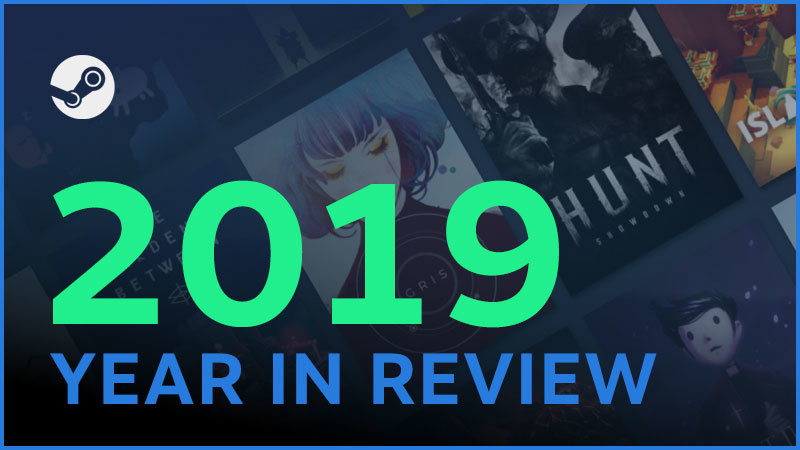
The Store
The Steam Community
The Big Library Update
Even More Ways to Play
With all of the ways Steam enables players to enjoy your games on Steam, we're happy to report that we delivered over 20 billion hours of gameplay in 2019.
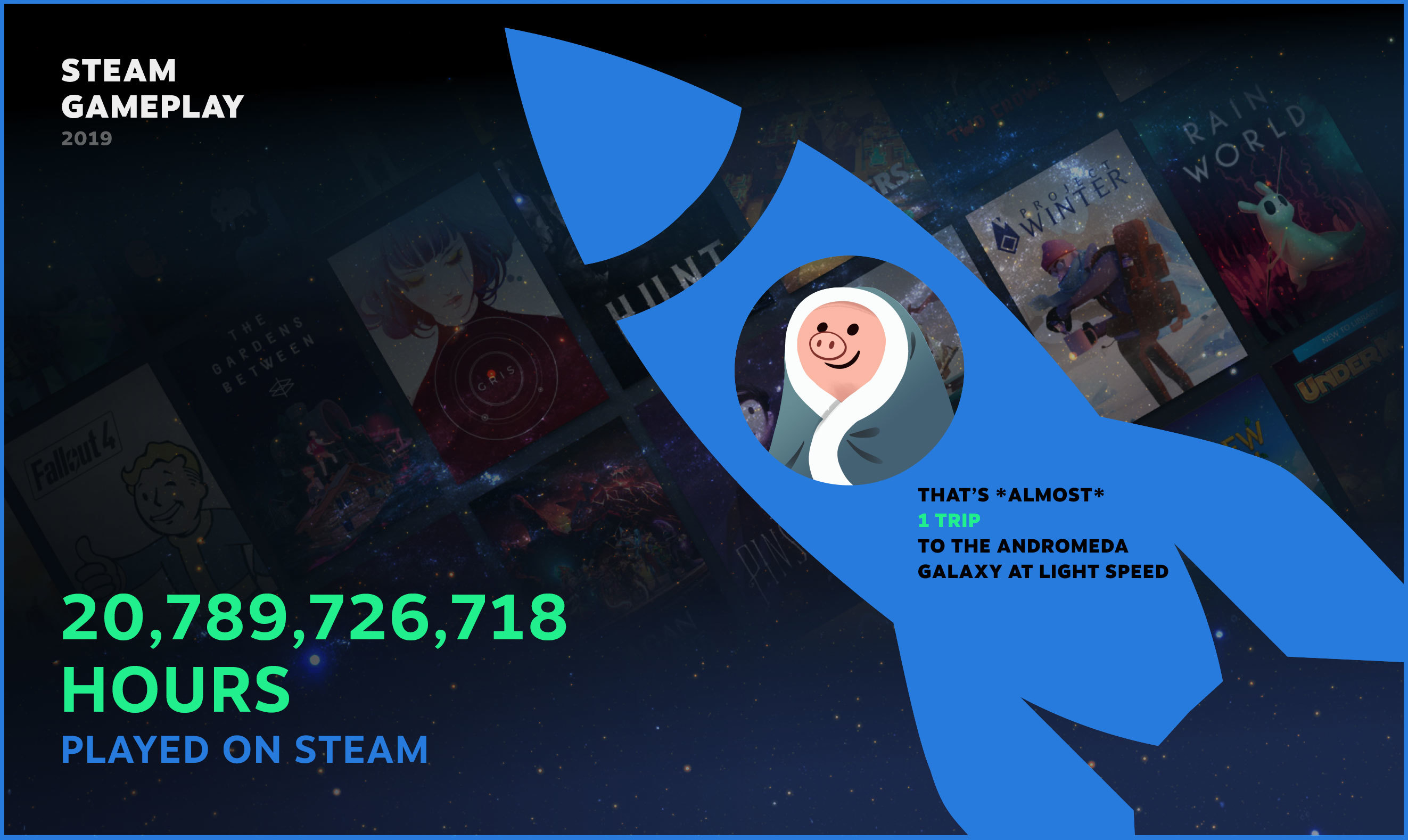
Steamworks Stuff You May Have Missed
Looking Ahead to 2020
Looks like it has been a really productive year for Steam as a platform, the changes made improved the results and while there were situations where developers got hit by unexpected side effects of some of this changes, 2019 has been a really interesting year and the platform is in a really good shape, we will see how this new changes affect the platform but so far, it's been good.
Labs is probably the best thing I have ever seen for a platform, the fact that we can interact with some tools even before release and help with development by giving feedback is something unique and quite fascinating.
What do you think about the changes made? do you think 2019 was a good year for steam? what was your favorite change?

This past year we've shipped a number of major updates and new features to Steam. In this post, we'll review these improvements, and share a bit about what's to come in 2020. For a recap of the work done in 2018, you can refer back to our previous Year in Review post.
The Store
When compared to 2018, more new releases found success on Steam in 2019, and median earnings among all new releases also rose
. These are big statements deserving of more detail to properly unpack, and as such, we plan to share more information in a series of "Steam Data Deep Dive" posts in the coming weeks. Until then, we can also share that the number of monthly active users on Steam increased to nearly 95 million, revenue from games made by our partners was up year over year, and 2019 finished strong with our most successful sale ever.
Steam Labs & Discoverability
The Store is an ever-evolving component of Steam, with thousands of games that cater to many different kinds of customers and their particular tastes. When designing new Store features, we aim to ensure the most relevant content is presented to customers.
While we experiment with features on the Store quite often, we usually don't ship them to everyone until they are more fully-baked. This can sometimes mean interesting ideas don't see the light of day, because their value can be hard to assess without a preliminary opportunity for user feedback. Steam Labs was created to get these nascent ideas in front of customers and gather feedback on whether they are worth pursuing. In collaboration with Ichiro Lambe from Dejobaan Games, we shipped Micro Trailers and the Automatic Show in July, along with our own machine-learning powered feature called the Interactive Recommender. Additional experiments on September 5th and the 19th brought improved Search, Community Recommendations, and a content discovery feature collaboration with Lars Doucet from Level Up Labs called Deep Dive. In the brief span that Steam Labs has been around, it has served 2.7 billion impressions, 57 million views, and has facilitated 6.1 million wishlist additions to over 29 thousand games.
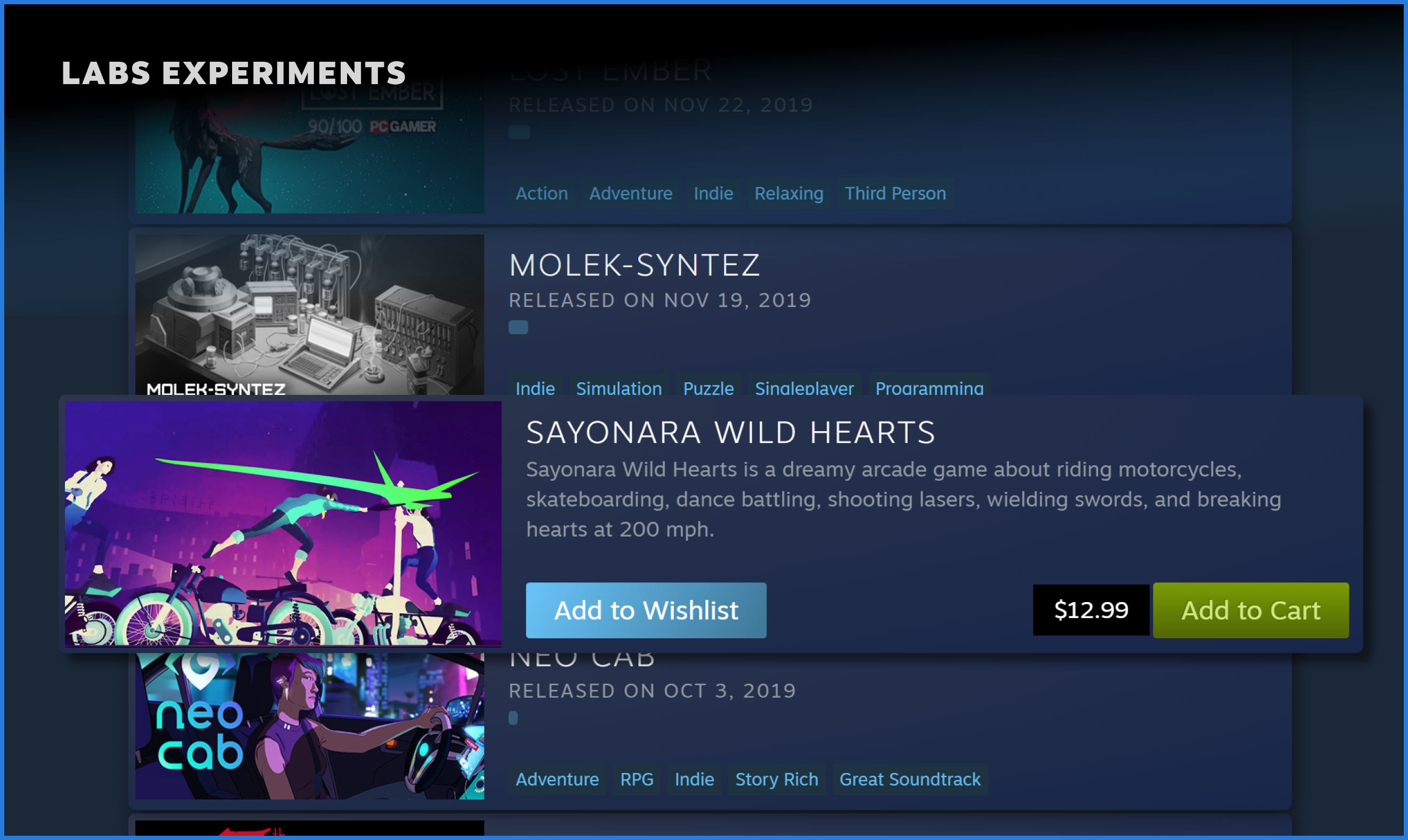
More Discoverability Improvements: DLC, Top Releases, and More
The year's first update in January made it easier for users to browse DLC for their favorite games by tags, top sellers, new releases, and developer-authored lists. Since launch, this new browsing experience has driven over 121 million visits to individual DLC pages. The Discovery Update in September revolved around improving the "More Like This" and "Recommended for You" sections of the Store. After receiving feedback from customers and developers, we rolled out a few experimental changes to help address some of the concerns with that update. We are still assessing the data and feedback from these experiments, and have plans to further improve game discovery in these areas.
Another new initiative in 2019 highlighted the Top Steam Releases each month (starting in April, then continuing in May, June, July, August, September, October,November, and December). Previously we would only build these sorts of lists at the end of year, such as in our "Best of 2019" post, but only so many games could realistically be included in such a breakdown. While the Store has several different versions of "New Releases," those lists generally look at data from the past 24 hours. These lists serve users who visit the Store regularly, but fall short for other customers who stop by less frequently. With these monthly posts and sale pages we've been able to call attention to more new games that have gained traction with the Steam community over a longer time period. Some of the lesser-known titles in these lists saw a 50% increase in wishlist activity in the days after they were featured.
We also worked on finding new ways to surface recommendations to users. For example, during the Winter Sale, we experimented with sending customized emails that recommended five games selected for that user by our machine-learning recommendation engine. We found that the user opt-out rate for this was low, and that users who received recommendations were more likely to discover interesting products. This is an area we expect to continue to experiment with in the future.
User Reviews
In March we shipped some new features to help mitigate the effect of "off-topic review bombs," which are concerted efforts to negatively affect the Review Score for reasons unrelated to whether future players would enjoy the game. Users Reviews are consistently one of the most used features on the Store, garnering as many page hits as Search, so it's important that they are accurate and trustworthy. As part of a new process, our team uses a combination of tools and developer feedback to identify anomalous review activity. After we've identified a potential review bomb, we then get together to dig into what happened and discuss whether the review activity should be marked "off-topic" (something we've done 44 times thus far). Once that determination has been made, reviews within these "off-topic" time periods will be excluded from the Review Score by default (a setting customers can change if they so choose).
The Steam Community
Steam Chat
Steam Chat was revamped in 2018, and as a follow-on in May of 2019, we released the Steam Mobile Chat app to keep users connected with one another while away from their PCs. The app was installed over one million times (1/3 iOS and 2/3 Android) and on average a million push notifications are sent each day.
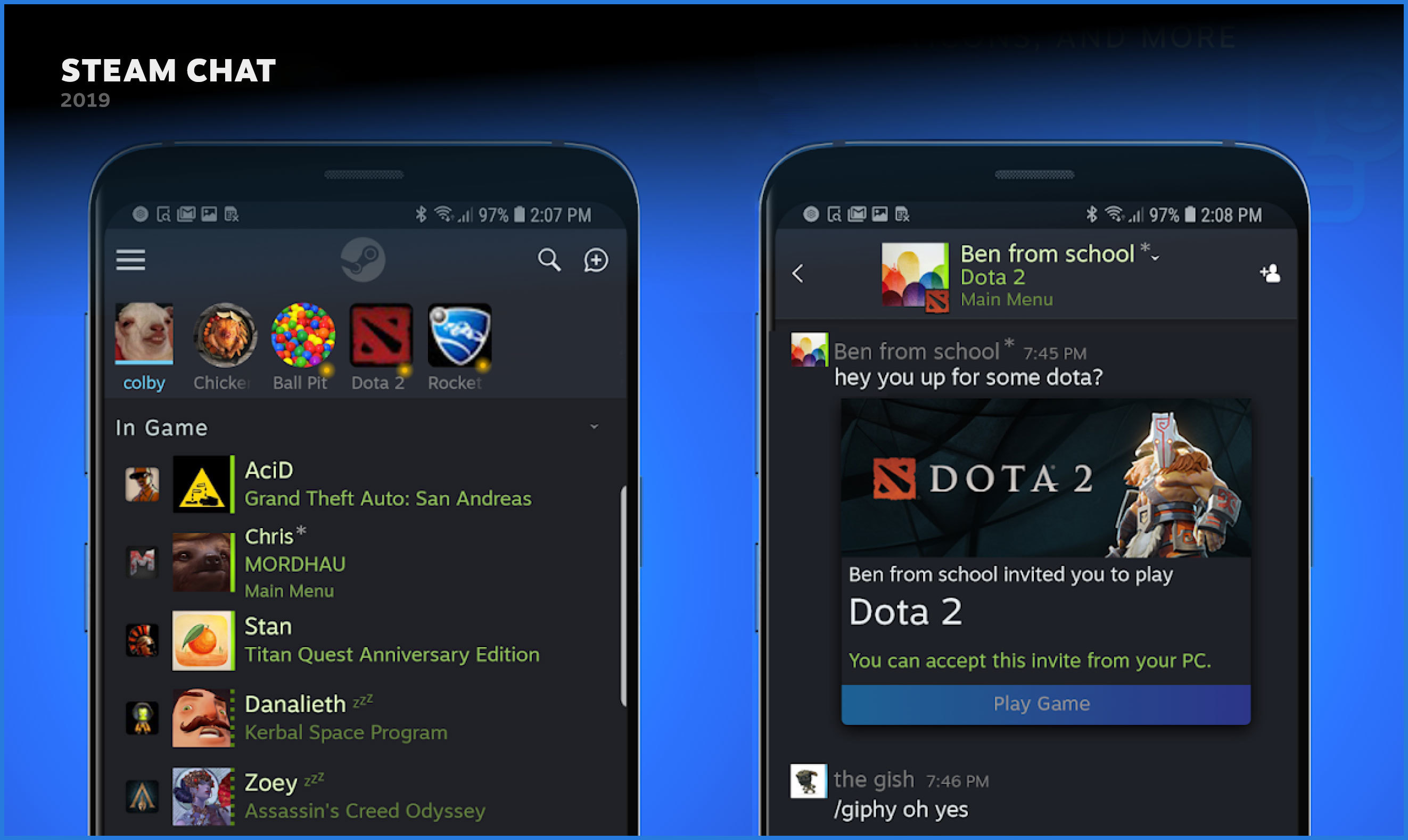
Recently, we also expanded the set of chat interactions possible with Chat Stickers and Effects. Usage of these new features has been pretty promising: during the Winter Sale over 6.6 million stickers were sent and 1.1 million chat effects consumed. For comparison, 9 million Winter Sale emoticons were used in chat during that same period.
Steam Workshop
The Steam Workshop continues to be a very popular feature among users: 4.3 million items were uploaded last year alone. Unfortunately, sometimes malicious groups would upload "fake items" (e.g "Click here for Free Skins!") with the explicit purpose of hijacking accounts. To help mitigate these types of scams, the Workshop submission process was updated to require email verification. We've since moved to pre-approving items for games that had the highest rate of abuse. There has been a drastic reduction in item scams since then, with very little cost to users: approval times are less than 15 minutes on average, thanks to our full-time moderation team.
Community-Building Events
Throughout the year, we incorporated community-building features into our various seasonal events, creating forums for meaningful engagement among players. For example, the annual Spring Cleaning event encouraged users to talk about and play games in their libraries. The same is true for the Steam Awards and the lively debate that surrounded all of its stages from nominations and voting, to the final unveiling of the winners. Similarly, sale events like the Grand Prix (even with its flaws) and the Winter Sale encouraged users to collaborate, get together, and play the games they love. Engagement with these events ranged between 33% and 66% of customers who shopped with us in these same periods, with many participating every day.
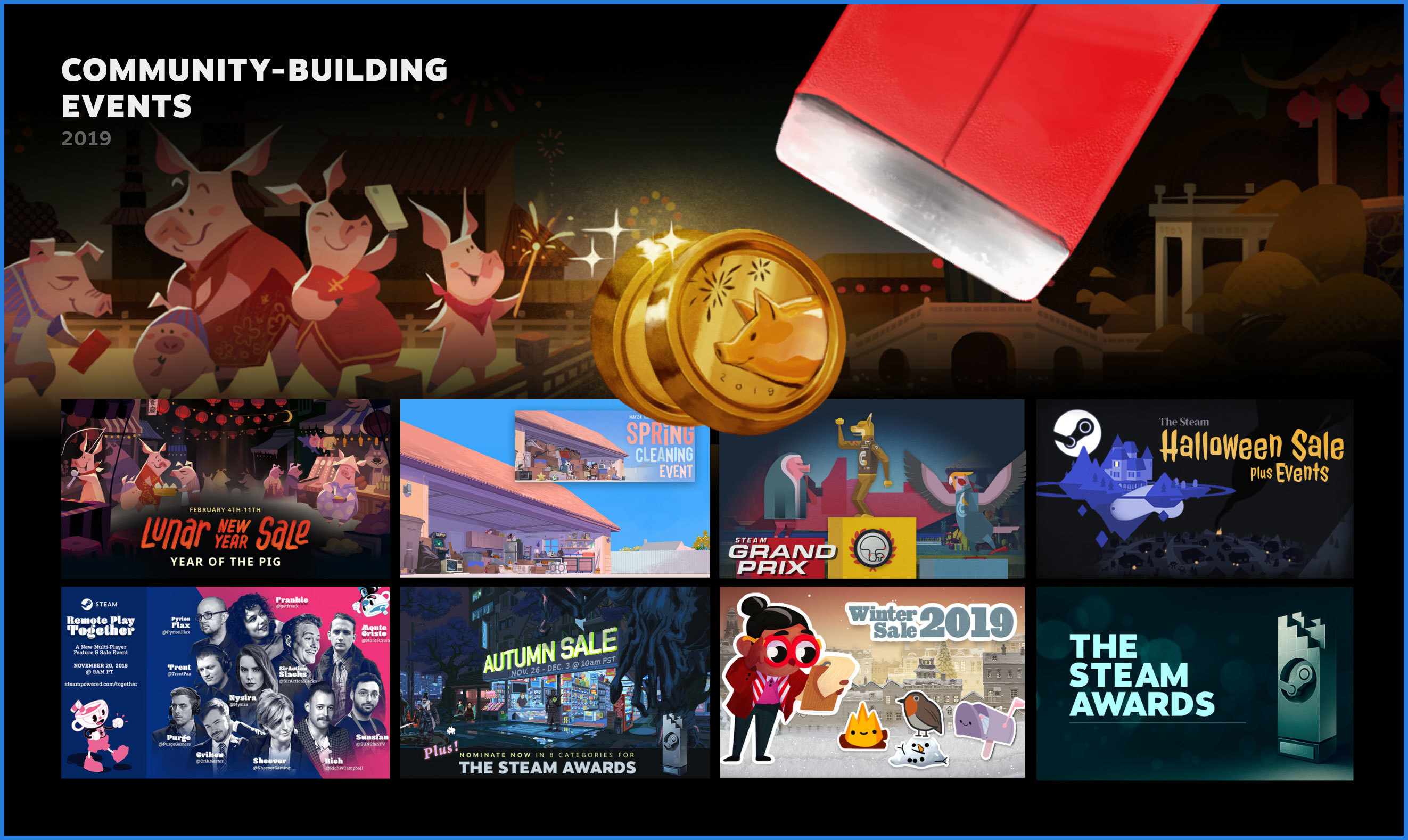
The Big Library Update
A lot of our team's effort in 2019 went into shipping a new version of the Steam Library–the place where players begin and end their gaming experience on Steam. The Steam Library, for the most part, had not really changed in many years. New features were added here and there, and it was all functional, but it was clear that we couldn't build the features we wanted fast enough without making larger-scale technical changes too. So after lots of design iteration and internal playtesting, the long-awaited Library Update finally entered open Beta in September. Beta participation was twice that of a typical Steam Beta, and following a dozen or so iteration cycles with participants, the new Steam Client was made available to everyone on October 30th.
The Library update introduced many new features that are interesting to both developers and players: tools to help players decide what to play next; an activity feed to surface interesting news, events, and user-generated content associated with the games they love; and improved game and library management.
One of the biggest improvements for game developers is the new Steam Events & Announcements system, which allows developers to communicate with their player base and prospective customers through new tools to post news and schedule in-game events. Through these posts, players can more easily learn about the latest updates for their games, be notified of limited-time events, and watch live-streams of their favorite games. These new events and announcements have so far been shown over 8 billion times to players, with over 5 billion of those impressions occurring in the new library itself. This has helped players rediscover games in their library and keep in touch with exciting activities and developments happening in the games they play.
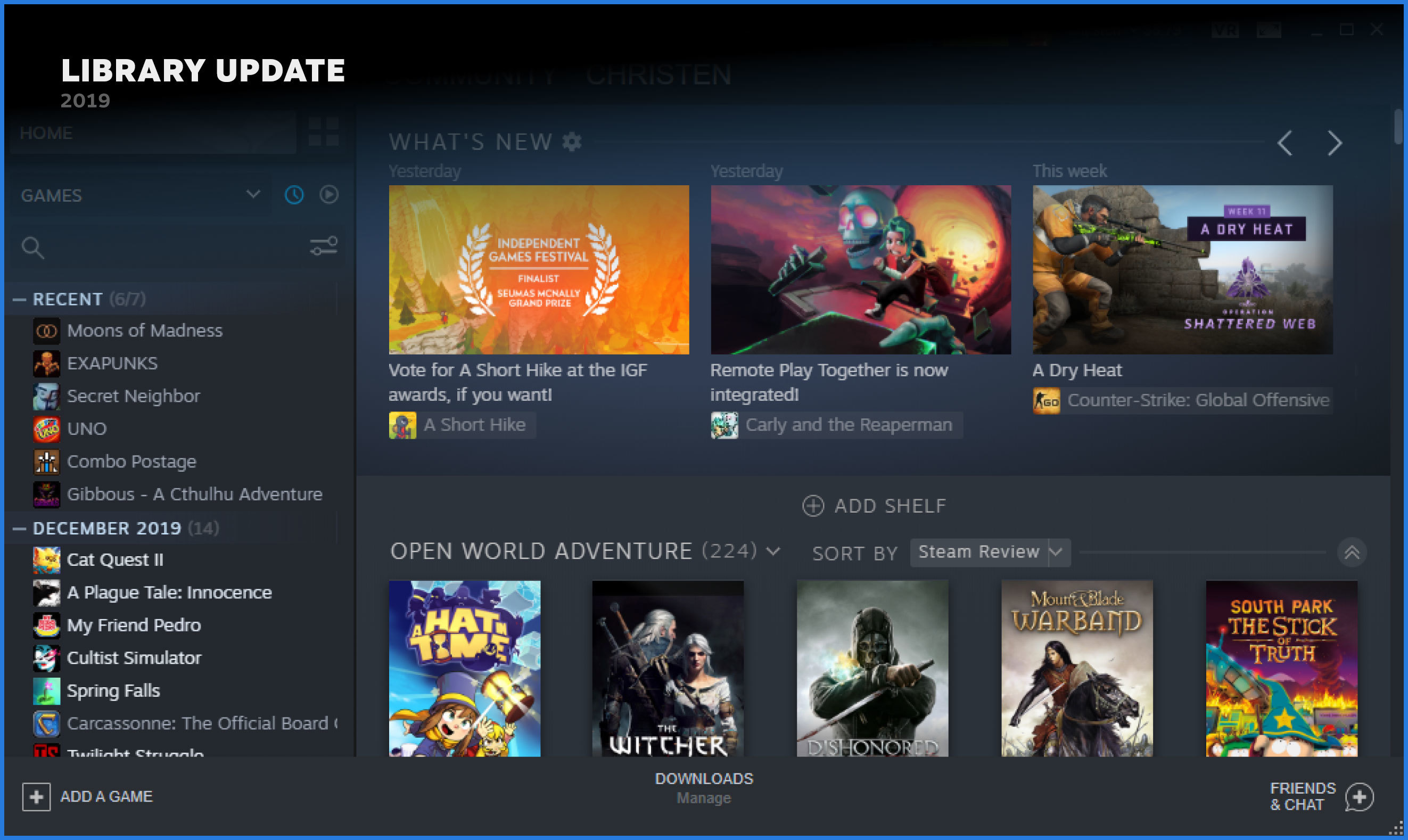
The updated library also introduced some new ways to prompt the user to review or re-review a game they have been playing based on certain criteria, which substantially increased the number of reviews written. We previously saw around 17 thousand new reviews posted per day across all games, but since the Library update, we now see 70 thousand reviews per day, for an increase of over 300%.
Even More Ways to Play
Steam Remote Play
In June, Steam In-Home Streaming received an update which allowed games to be streamed and played outside the home, which of course necessitated a name change to Steam Remote Play. Paired with the Steam Link app, this meant that users could play Steam games on their phone or tablet (iOS, Android, or Raspberry Pi) while on the couch or anywhere with a decent Internet connection. Then in November Remote Play Together was released, which made it possible for local multiplayer-only games to be played with friends on the other side of the Internet. In just the last two months of the year, over 3.7 million players used Remote Play and over 2.3 million used Remote Play Together. And since we've published documentation on Optimizing for Remote Play, over 300 games can now be easily played with touchscreen controls on either a phone or tablet via the Steam Link app.

Steam Play For Linux
Steam Play for Linux, which uses a modified distribution of Wine called Proton, celebrated its first birthday in August. When we talked about Steam Play for Linux last January, the community had reported that over 3,400 games were compatible. Today that number is over 6,500. This is all super exciting for us, because it means that users can realistically play a huge number of games on the platform of their choice, with no additional work required by developers. Proton continues to see improvements, further decreasing the performance overhead to gaming on Linux. Alongside these Proton changes, we also looked to improve shader compilation specifically with gaming in mind; this resulted in the release of ACO, a new Mesa shader compiler for AMD hardware. Not only has ACO led to a decrease in shader compilation times, but some promising initial results have shown that it could improve in-game performance as well.
SteamVR
This past year we continued our commitment to high-end PC VR. Back in April, we announced our own headset and controllers called the Valve Index, which began shipping to customers in June. The Index headset and controllers were designed from the ground up to push the envelope for what was possible with high-fidelity VR experiences, from graphics to audio to input. While we believe that the Index delivers the best-in-class VR experience a user can have, it certainly isn't the only way to experience VR games on Steam. SteamVR supports nearly two dozen headsets, including the HTC Vive & Cosmos, Oculus Rift & Rift S, Pimax HMDs, Samsung Odyssey, and many other Windows MR headsets.
Speaking of the software side of things, SteamVR had over a hundred beta updates throughout the year, with nearly a dozen "point" releases making it out to the public at large. It was largely a year of stability fixes, but some notable changes added support for Oculus Rift & S and Motion Smoothing for AMD GPUs, plus big improvements to the VR View window, audio management, and settings. Oh, and we also revealed Half-Life: Alyx to the world in November, and are pushing towards a March 2020 release.
With all of the ways Steam enables players to enjoy your games on Steam, we're happy to report that we delivered over 20 billion hours of gameplay in 2019.

Steamworks Stuff You May Have Missed
As mentioned earlier, the Steam Library now makes it easier for customers to discover developer-authored news and events. Part of that work was to create all-new authoring tools that allow for richer, move visually-interesting posts. In addition, developers can now see how many users have seen an announcement (an impression) or clicked-through to actually read it.
Throughout the year our team has traveled to various conferences and meetups around the world to give talks and a general update on the Steam Platform. If you weren't able to attend one of those events, you can watch the presentation we gave at GDC in March. Not everything can be included in a talk, though, and after receiving feedback from developers, it was clear that we could do a better job surfacing the tools and features that Steamworks has to offer. To help address that, in May the homepage of Steamworks was revamped to communicate the many features and services available for use in your games.
We also started publishing newsletters in the Summer and Fall, as a test to see if this regular form of communication was beneficial to partners. These posts not only collated several previous announcements for easy perusal, but they also also served as a good place to talk about some smaller changes, such as the ability to add tags to a game directly on the partner portal, support for localized trading card assets and game names, new Daily Active Users reports, and updates to the Release Process with reminder emails, among other things.
Looking Ahead to 2020
Last year's post provided a sneak peek at some projects we planned to complete in 2019. It's natural for priorities to shift throughout the year and for the team to re-evaluate where to best allocate our resources. Still, out of the eight things we listed, six shipped in some form, with work continuing on the rest. Here are some things you can expect to see from us this year:
- Data Deep Dives - We've seen a lot of analysis from third parties that have taken a stab at figuring out how games are doing on Steam (and overall health of the platform), based on the limited amount of data that is publicly available. Since we have access to more data, we thought it would be useful to do our own analysis and share the results as a multi-part series of blog posts.
- Soundtracks - We're adding new functionality to better support gaming soundtracks.
- Steam Trust - Trust (the tech behind Trust Factor Matchmaking in CS:GO) shipped in a closed beta to several partners last year and is being rolled out to all partners later this year.
- Steam PC Café Program - Launched in an open beta last year to over 8 thousand sites, we're working on bringing the program to schools and libraries, along with the expected Cybercafés, PC Bangs, VR Arcades, etc.
- Steam Labs - More top secret experiments are actively being tinkered with, and we're planning on graduating some of these features so that they are available to everyone.
- SteamVR - The team is hard at work on SteamVR 2.0, which will feature a number of customer experience improvements.
- Top Lists - We're taking what we learned from the top lists posted in Steam News this past year to develop new store destinations designed to display compelling trending content to customers.
- Steam Mobile App - The mobile app is getting a refresh to add more login types and help users secure their accounts.
- Sale Events - Building on features that first shipped in the 2019 Lunar New Year sale, we're exploring more ways to reward users for participating in sale events throughout the year.
And of course we expect to release lots of improvements to Steam TV, Chat, the Library, the Store, and other existing features.
There are more projects that we're not quite ready to talk about just yet. Interested in helping out? Please send us your feedback on what's important to you, and if you want to join us in the trenches, we're always hiring.
Looks like it has been a really productive year for Steam as a platform, the changes made improved the results and while there were situations where developers got hit by unexpected side effects of some of this changes, 2019 has been a really interesting year and the platform is in a really good shape, we will see how this new changes affect the platform but so far, it's been good.
Labs is probably the best thing I have ever seen for a platform, the fact that we can interact with some tools even before release and help with development by giving feedback is something unique and quite fascinating.
What do you think about the changes made? do you think 2019 was a good year for steam? what was your favorite change?
Last edited:



